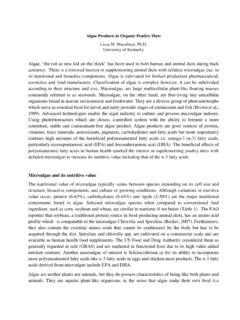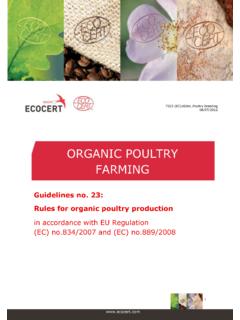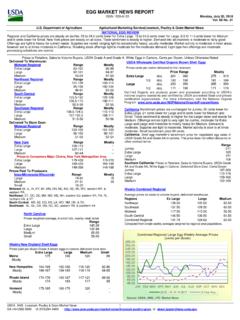Transcription of The role of poultry in human nutrition - Home | …
1 1 FOOD AND AGRICULTURE ORGANIZATION OF THE UNITED NATIONS poultry DeveloPment reviewThe role of poultry in human nutritionThe nutritional benefits of chicken meat compared with other meatsDavid Farrell, School of Land, Crops and Food Sciences, The University of Queensland, St. Lucia 4072, Queensland, Australia Chicken meat is a white meat, distinguished from other meats such as beef and lamb by its lower iron content ( mg com-pared with 2 mg/100 g). ChiCken meaT has several advanTages over oTher meaTsThe fat content of cooked chicken varies depending on whether it is cooked with the skin on or off, the portion of the bird, and the bird s diet and breed. Breast meat contains less than 3 g fat/100 g. An average value for dark meat (skin off) is 5 to 7 g/100 g. About half of the fat from chicken meat is made up of the desirable mo-nounsaturated fats, and only one-third of the less healthy satu-rated fats.
2 There are much higher proportions of saturated fats in most cuts of red meat, which also vary considerably in total fat. Chicken meat is therefore seen as a healthy meat. Chicken meat does not contain the trans fats that contribute to coronary heart disease, and can be found in high amounts in beef and lamb. In Canada, values of 2 to 5 percent have been reported for beef and as high as 8 percent for lamb. The World Cancer Research Fund and others (Bingham, 2006) have suggested that the consumption of large amounts (more than 500 g/week) of red meat, particularly processed meat, but not chicken meat, may be unhealthy. poultry meaT is riCh in The omega-3 faTsPoultry meat is an important provider of the essential polyunsat-urated fatty acids (PUFAs), especially the omega (n)-3 fatty acids.
3 Scavenging chickens are a particularly good source because of their varied diet. The amounts of these important fatty acids can be increased more easily in chicken meat than in other livestock meats; so too can some trace minerals and vitamins. The recom-mended dietary intakes (RDIs) of niacin can be met with 100 g of chicken meat per day for adults and 50 g for feeding broiler chickens only small amounts of a sup-plement rich in alpha linoleic acid (an n-3 PUFA), such as flax seed, the n-3 PUFA in thigh meat can be increased from 86 mg to 283 mg/100 g, and that in the minced carcass from 93 to 400 mg/100 g. To a large extent, the fat contents of the differ-ent portions determine the content and enrichment of PUFAs, so dark chicken meat always contains more PUFAs than white breast meaT Can be enriChed wiTh several of The imPorTanT dieTary nuTrienTsUnlike most other meats, chicken meat can also easily be en-riched with several other important nutrients.
4 A recent study (Yu et al., 2008) showed that by adding mg of selenium (as organic selenium) per kilogram of feed, the selenium content of breast meat was increased from g to 41 g/100g, which is more than 65 percent of the RDI. The same amount of selenium in the form of inorganic sodium selenite also increased selenium in the breast meat, but only to 16 g/100g. Selenium deficiency is becoming more widespread in humans because soils are becom-ing depleted and the foods grown on them are therefore lower in selenium. The RDI of selenium is 55 g per day. Selenium is a powerful antioxidant and plays a role in the prevention of some forms of cancer. A deficiency of selenium can cause Keshan s dis-ease, a heart ailment in the young, which is common in parts of China, and cognitive decline in adults.
5 Enriched poultry meat could help alleviate this meat can make many positive contributions to the diet of those on low incomes. Although not all meat is seen as healthy, chicken meat is, and is frequently more affordable than other meats. It is of a consistently high quality, is low in saturated fats, can be enriched with some essential nutrients and is sought after , s. 2006. The fibre folate debate in colo-rectal cancer. Pro-ceedings of the nutrition Society, 65(1): 19 , , na, , kim, , kim, , kang, , kim, , seo, & lee, 2008. Effects of dietary selenium sources on the growth performance and selenium retention of meat in broiler chick-ens. Proceedings XXIII World s poultry Congress, 29 June 4 July 2008, Brisbane, Queensland, Australia. (on CD)The designations employed and the presentation of material in this information product do not imply the expression of any opinion whatsoever on the part of the Food and Agriculture Organiza-tion of the United Nations (FAO) concerning the legal or development status of any country, terri-tory, city or area or of its authorities, or concerning the delimitation of its frontiers or boundaries.
6 The mention of specific companies or products of manufacturers, whether or not these have been patented, does not imply that these have been endorsed or recommended by FAO in preference to others of a similar nature that are not mentioned. The views expressed in this information product are those of the author(s) and do not necessarily reflect the views of FAO.


















